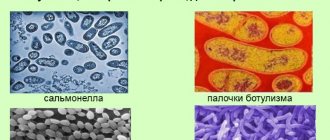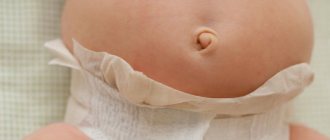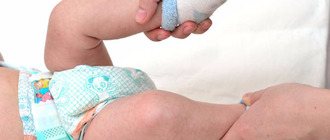Often young mothers worry about the condition of the child, looking at his diaper. To determine whether the condition of the child’s stool requires a doctor’s attention, let’s figure out which signs are considered normal and which require a doctor’s intervention.
After birth, a newborn's stool appears as a dark green, sometimes even almost black, mass called meconium. Meconium is replaced by regular stool within a few days.
In babies whose mother is breastfeeding, the stool is bright yellow, the consistency is mushy, the smell is sour, often in the first days after birth you can see white flakes in the baby’s stool - this is undigested milk, which means that the baby’s stomach has not yet adapted to mother’s milk, There is no need to panic in this case; as a rule, everything gets better quickly.
Babies who are bottle-fed are less likely to have bowel movements and their stools are pale yellow in color and have a denser consistency.
Often, young mothers are concerned about their newborn's stool, especially when they notice the baby's stool with mucus, which has also changed its color to greenish. You may also see a small amount of foam in the stool. All these signs may indicate that the baby is sucking the mother's front milk, but the hind milk remains, the breast is not completely emptied, but it is the hind milk that is the most beneficial for the baby, the problem in this case is easy to solve - you need to let the baby empty the breast until end.
Stool with mucus in a baby in the first months is quite normal; mucus in the stool appears due to a lack of lactose; after a few months everything returns to normal.
Often, mucus during bowel movements occurs in babies whose mothers are trying to “improve” their diet to increase the amount of milk. They try to eat more walnuts, drink whole milk, and even add condensed milk. But newborns have too immature enzymatic apparatus, the baby is simply not able to digest fatty foods.
Don’t go overboard with foods, review your nutritional composition. Also beware of indulging yourself with delicious foods such as cakes, caviar, and sausage.
Normally, in the first two months after birth, the baby should “go big” after each feeding, then less often - about 4 times a day, and after six months - about 2 times.
In the early period of development, children have a very sensitive intestine, and often disorders can occur under the influence of bacteria that do not affect the intestinal microflora at an older age. Even vegetables can cause diarrhea in babies. Therefore, changing the composition of the diet must be done very carefully.
Often when complementary foods are added, the baby's stool may turn orange or reddish. Undigested vegetable fibers and mucus may also be found in stool. Typically, such disorders go away quite quickly if they are treated in time.
But if your child’s stools become frequent, watery, brown or green in color with an unpleasant odor, and the baby does not gain weight, or even loses it, then your baby has an intestinal disorder. Causes may be allergies, infections or poisoning.
Severe symptoms of the disorder, in addition to those listed, may also include vomiting, a temperature of about 38, and the appearance of gray circles under the eyes. You will need to see a doctor.
A doctor's attention is also required if the child develops lactose intolerance. Signs of its appearance will be green stools with abundant foam and gas. The smell will be sour and pungent. Irritation appears around the anus, the baby becomes restless. Lactose deficiency can lead to disruption of intestinal microflora, because the acidic environment affects the number of beneficial microorganisms.
It will be necessary to conduct a scatological examination and stool analysis for carbohydrates. You and your doctor will need to adjust your diet. Of course, once the diagnosis is confirmed, it will be necessary to exclude the consumption of fresh milk. If this does not have an effect, then a reduction in consumption of fermented milk products may be recommended. In more complex cases, lactose replacement therapy is prescribed.
The combination of mucus and green stool in a baby may also indicate dysbacteriosis. Then the mother is prescribed to donate breast milk for culture and, having determined the sensitivity to antibacterial drugs, treatment is carried out.
Here are the most basic points that will help you not be afraid of stool with mucus in your baby. It is not always possible, of course, to avoid more severe disorders in the baby. But you need to approach this without unnecessary panic, see your doctor in time, and correct your actions.
Noticed a mistake? Select it and press Ctrl+Enter to let us know.
The appearance of green stool in an infant worries many mothers. The stool of a baby who eats formula is different from the stool of a baby who eats breast milk: such stool is darker, sparser, thicker and smells unpleasant. In other words, it resembles adult stool.
Green chair
If your baby has green stools
Breastfed babies often soil their diaper, their stool is bright yellow or a little darker, without an unpleasant odor. The consistency of the stool, whether smooth or not, may contain curdled grains. If you leave the diaper for a while, you can see that its color gradually changes to green. This is a normal option and should not worry parents. The cause of the greenish tint of stool can also be bilirubin, which is gradually eliminated from the body with feces.
Also, if a breastfeeding baby has green stool, it depends on the mother's diet. If the mother eats green foods - spinach, parsley and dill, broccoli - this can affect the color of the baby's stool. The same applies to babies who are already getting vegetables - after a good portion of broccoli for lunch, the baby will go into the diaper in a greenish mass.
If your baby has green, foamy stools, you should tell your doctor . Such stool is a sign that the baby is receiving only “fore milk”. This food is more liquid and less fatty than milk, which the baby gradually sucks after 3-5 minutes at the breast. Such nutrition is dangerous because the baby does not have enough lactase (it is produced in a relatively small amount in the baby’s body), gases begin to torment him, and the contents of the diaper become green and foamy.
The mother of such a baby can be advised to establish proper breastfeeding: do not remove the breast too quickly. In addition, sometimes there are cases when the mother’s breast produces a large amount of milk, the child simply does not have time to get to the hindmilk, which is fattier, and gets full. In this case, experts advise changing breasts less frequently during feeding. And finally, if lactase deficiency occurs, which cannot be overcome by the measures described above, the pediatrician prescribes special enzymes that need to be diluted in breast milk and given at the beginning of feeding. Before this, the pediatrician will ask you to take special tests. Thus, the appearance of green stool in an infant may be a sign of lactase deficiency.
There is mucus in the baby's stool
The presence of green stool with mucus in an infant can be one of the signs of dysbacteriosis . In addition to green stools, parents may notice skin rashes, the baby may have colic, sleep disturbances, and may become restless. If an infant has green stool with mucus, as well as if there are bloody fragments, this is a reason to immediately dial a doctor and consult . Read more about dysbiosis...
Greens in the stool of a formula-fed baby may appear because the formula is not suitable for the child. It is worth changing it (of course, under the supervision of a pediatrician) and paying attention to the reaction of the child’s body. Another possible cause of greenness may be iron, which is found in some mixtures.
On this topic:
- Diarrhea in an infant
- Constipation in a baby
Do you want to be the first to read our materials? Subscribe to our telegram channel, Facebook page, or VKontakte group.
We are at Yandex.Zen - join us!
Educational games for children from 2 to 10 years old.
For an infant, and especially for a newborn, green stool is one of the normal bowel movements. Mostly, young parents sound the alarm unreasonably, only when they see the green color of the stool do they begin to get nervous and try to help the child, who at the same time feels great. Doctors always give only one advice in this case - do not prescribe treatment for the child yourself, but contact a pediatrician.
Characteristics of slime
In the first 3 months of a baby’s life, the presence of mucous impurities is allowed in the excrement. This is explained by adaptation to a new way of obtaining nutrients and the peculiarities of the children's intestines. If there is a moderate amount of mucus in the baby's stool, but the baby is not restless, there is no need to worry.
Loose stool in a breastfed baby, which is accompanied by the appearance of mucus of an unknown color and a deterioration in health, indicates that you need to visit a pediatrician.
| Possible variants of impurities in feces in infants | |
| Green stool with mucus | The appearance of such stool provokes intestinal dysbiosis. It is often accompanied by colic, restless sleep, and the appearance of rashes on the baby’s skin. |
| Loose stools with mucus | If the baby is in good health, this condition is the limit of normal. Stool can be observed with early or illiterate complementary feeding, as well as if the menu of the nursing mother has changed. |
| Pink slime | It is observed in cases of serious intestinal diseases, as well as in the presence of ulcerations of the intestinal mucosa. If, in addition to this sign, the baby is vomiting, there are chills and there is an urgent need to hospitalize the baby in a medical facility. |
| Brown slime | This mucus contains blood. This phenomenon often occurs in children with hard stools. |
| Transparent slime | Such mucus appears if a nursing woman’s menu has changed, and the enzymes of the digestive system are not able to digest new foods. If such mucus is present on a constant basis, the baby’s intestinal flora is disturbed. |
| Yellow stool with mucus | Such stool signals that an infection has entered the body. The yellow color of mucous formations indicates a disturbed intestinal flora. Often such stool in a baby is accompanied by bloating, dry skin, intense thirst, and increased heart rate. |
| White slime | Stool with whitish spots usually provokes parasite infestation. If such a sign appears, you should visit a pediatrician, as this can cause significant harm to the child’s health. |
| Lumpy stool | White lumps that resemble curdled milk are more common in the stool of babies who are breastfed on demand. Enzymes do not have time to process the milk, and it comes out in the form in which it arrives. With normal weight gain, this is not harmful to the baby's health. If a child eats natural milk, there are lumps in the stool, but weight gain is insufficient, this indicates an enzyme deficiency. That is, food does not have time to be digested by the intestines. In this case, the pediatrician prescribes enzyme preparations. |
Green stool in a newborn
When a child is born, his intestines are cleansed during the first days of life from digested intrauterine secretions. That is why the first few bowel movements of a newborn are dark green in color and have a rather thick consistency. Since the child is in the maternity hospital ward after birth, doctors carefully monitor the condition of his stool.
It is not for nothing that a newborn’s temperature is measured every four hours, since if, in addition to green coloring of the feces, symptoms such as fever and the presence of mucus in the stool are present, then after laboratory tests an intrauterine infection can be diagnosed.
Breastfeeding is of great importance for the formation of proper bowel function, if there are no medical contraindications to it. No formula can replace breast milk. Those newborns who are immediately transferred to artificial feeding often have stable digestive problems.
Physiological reasons
- The mother's diet contained a product that caused the staining (a large amount of eaten greens, apples, and other products of plant origin).
- The introduction of the first complementary foods caused staining - it should go away within two days.
- The onset of teething can change the consistency and color of stool, a process that can last a week.
Parents should not sound the alarm if the green coloration of the stool is not accompanied by an increase in body temperature, vomiting, lethargy, or whims . If the child is active, but there is mucus, blood prints, or a large amount of it in the feces, this is a reason to seek advice from a pediatrician.
Pathological processes that cause green stools
It is worth understanding step by step the causes of pathological processes in the intestines of a breastfed baby. So, very often mothers who really love dairy products do not think about the fact that their child may have basic lactose intolerance. Mother's breast milk is absorbed well by the baby, but when the mother overdoes it with dairy products, the baby develops greenish mucus in the stool.
On the one hand, it seems that this is a harmless phenomenon that will go away on its own in a couple of days, but it can cause a more serious disease - dysbiosis. Dysbacteriosis can be caused either by the lack of positive microflora in the baby’s intestines from birth, or over time, as a result of poor nutrition. Therefore, mothers need to carefully monitor their diet.
When your baby's stool is runny and foamy, this indicates that there are not enough nutrients in the mother's milk . Of course, the doctor will prescribe basic smears and other tests, since he must be sure that the child does not have E. coli and other health problems. The problem may also lie in the excessive fat content of the mother’s breast milk, then she is prescribed a special diet, adhering to which she improves the functioning of the baby’s intestines.
One of the reasons for this condition in an infant may be rotavirus . This is a rather complex disease from a medical point of view, which in infants is treated in a hospital. Its symptoms may be:
- High body temperature.
- Frequent green stools with mucus.
- Abdominal pain and bloating.
- Frequent vomiting.
- Moodiness.
- After rotavirus, the baby's intestines need to be repopulated with beneficial bacteria. Self-medication of this disease and diagnosis are strictly prohibited.
What does the presence of mucus indicate?
Loose stools with mucous impurities are considered normal for infants. Immediately after birth, a newborn baby produces meconium, which is the original feces. It includes the following components:
- water;
- slime;
- beneficial bacteria;
- bile;
- amniotic fluid;
- epithelial cells.
Meconium formation occurs before birth. The substance leaves the body in the first 2–3 days of life. The mass has a viscous consistency and dark color.
After this, the stool turns yellow and turns into a jelly-like texture. It can also be watery. The presence of loose stools with mucous impurities is considered normal for children 3–4 months old. This condition should not be a cause for concern.
During the digestion of mother's milk, acids and alkalis are formed in the baby's intestines. Mucus is produced to protect the digestive organ from the aggressive effects of biochemical processes.
In normal conditions, loose stools with mucus are observed quite rarely in infants. This is explained by the mixing of its small inclusions with feces in the large intestine. In cases where mucus rarely appears in the form of individual fragments, you don’t have to worry
Prevention measures
Disease is always easier to predict. To do this, the most important thing is to follow the basic rules for preventing green stool with mucus:
- Mother's compliance with the lactation diet.
- Gradual introduction of complementary foods with possible temporary withdrawal.
- Monitoring baby hygiene.
- Control over the quality of food that is given to the baby along with breast milk.
- At the first sign of an intestinal infection, call a doctor at home.
The most important thing is the love and care of parents for their children . If the child is properly cared for and does not have a congenital pathology of the gastrointestinal tract, then he is not in danger of developing green stool with mucus. Parents should always adhere to the pediatrician’s recommendations and not rush to introduce complementary foods to their child until his intestines are stronger and can independently digest adult food; each baby experiences this period at different times; parents should not force events in order to avoid unpleasant consequences.
- What should a newborn's stool look like?
- When is the presence of mucus normal?
- When to see a doctor
- What pathologies cause mucus?
- Video on the topic
When they bring a newborn baby home, not all parents understand how to properly care for him. It is not clear to everyone what baby behavior is considered normal and what is a sign of pathology. Especially many questions arise about the stool of a newborn. Not all parents imagine what it should be like normally. Therefore, if they notice a change in color or mucus in the stool, they begin to worry. But in fact, each child is individual, his stool can be anything, and if the baby’s well-being and appetite are good, then this is normal.
How to diagnose pathology by the nature of stool
Although mucous inclusions are always present in stool, loose stools with mucus can only appear when there is a problem in the intestines. How to determine what is happening inside a small organism? The table below describes the main characteristics of stool and suspected problems.
We recommend: Are diarrhea and cough dangerous in a child without fever - what do parents need to know?
| The number of discharges and their nature | Presence of pathology |
| Increased mucus volume | The more discharge, the stronger the inflammatory process |
| Transparent selections | Possible enterovirus, intestinal wall inflammation |
| Green or yellow mucus | A bacterial infection has joined the inflammatory process |
| Pink slime | Indicates that there is bloody stool, or there are ulcers on the intestinal walls |
| White slime | Indicates the presence of a parasitic disease; in case of constipation, it warns of neoplasms in the intestines, for example, polyps |
What should a newborn's stool look like?
Green stool with mucus in a baby after birth is most often a sign of normality. His digestive system is still imperfect, many enzymes are missing, and the microflora has not formed. This is exactly the color it should be when milk is digested. Gradually, the child’s digestion will normalize, and the color of the stool will become more familiar.
During the first 3-5 days, the baby passes original feces - meconium. It is thick, viscous, dark green, almost black. This is amniotic fluid, amniotic fluid and epithelial cells that the child swallowed during intrauterine development. Gradually, the color and consistency of the stool changes. Now the baby's stool is greenish or gray. All these are signs of normality, if the child eats well, gains weight, and does not suffer from colic.
When breastfeeding, the nature and color of the stool is affected by the mother's diet. When eating vegetables and fruits of bright colors or foods with dyes, it may acquire unusual shades. Infants often have green stools, but they are usually yellow-green in color. Sometimes streaks of mucus appear in the stool. If this is not accompanied by anxiety, colic or loss of appetite, then the baby is healthy.
Treatment
It is necessary to understand that the liquid consistency of a baby’s stool in itself is not yet a pathology, because, basically, a child at this age drinks mother’s milk or diluted formula. The presence of mucus can also be physiological, so parents should carefully monitor the child’s well-being, his mood, the amount and frequency of urination, weight gain and appetite. If these indicators are normal, there is no need to worry. However, if you notice negative dynamics, it is worth starting treatment:
- Diarrhea with mucus in a child can lead to dehydration, so you need to give him plenty of liquid: still mineral water, unsweetened dried fruit compote (it contains substances that improve peristalsis), chamomile tea, which has anti-inflammatory, anti-allergenic and carminative effects;
- Use enterosorbents - drugs that adsorb toxins on their surface. These include: Polysorb, Smecta, White Coal (preferably in a suspension, which is prepared by adding boiled water to a 250 ml bottle of powder, and then vigorously shaking). Such drugs are prescribed for suspected acute intestinal infection;
- Electrolyte solutions will help avoid the loss of microelements and maintain water-salt balance. For infants with diarrhea of any etiology, it is recommended to use Humana Electrolyte - a hypoosmolar mixture that stimulates the replenishment of missing fluid and has a pleasant taste (fennel or banana), which is important when consumed by children, as well as Regidron, which is effective against increased acetone, rotavirus infection and dehydration of any origin;
- If diarrhea is caused by an allergic reaction, it is appropriate to stop the child’s contact with the likely irritant and take antihistamines, for example, Tavegil (available in suspension for children up to one year old) or Fenestil (drops for oral administration);
- In case of dysbiosis, it is important to give preference to adapted formulas (if the baby is bottle-fed) and not to forget about prebiotics that help maintain normal microflora in the large intestine: Linex, Bifiform-Malysh, Acipol, etc.;
A consultation with a pediatrician is required, before which the child must stop eating so that the doctor can adequately assess the quality of stool.
When is the presence of mucus normal?
There is a small amount of mucus in every child's stool. This is evidence of the normal functioning of the gastrointestinal tract, because mucus is necessarily present in it. But some parents worry when they see mucous streaks in their newborn's stool. In this case, you can consult a doctor who can help determine whether your child has problems.
In the first 2-3 months, the baby’s digestive system receives a very heavy load. She is just adapting to new food. Since mucus is directly involved in the digestive processes, its impurities will be observed in the child’s feces. This happens especially often with artificial feeding or with the early introduction of complementary foods. It is not recommended to give additional food to a baby before 5-6 months.
Breastfed babies are highly dependent on their mother's diet. Everything she eats ends up in the milk and can cause changes in the baby's stool. It is not recommended for a woman to eat allergenic foods, brightly colored vegetables and fruits, and food with synthetic additives. Eating gas-forming foods, such as cabbage, legumes, white bread, and sweets, causes colic and flatulence in an infant. And the inflammatory process in the intestines leads to the appearance of mucus in the stool. It is also undesirable for the mother to take any medications unless absolutely necessary.
Typically, green stool with mucus appears in infants due to improper attachment to the breast. If the baby does not latch onto the entire nipple, it is difficult for him to suck out enough milk. This also happens in premature babies who are still weak. In these cases, the baby does not receive the most valuable “hind milk”, which contains all the necessary minerals, proteins and enzymes for their digestion. It sucks only liquid, which is low in nutrients and fat. As a result, the infant's stool becomes greenish and mucous.
Similar changes in the baby's stool occur with improper feeding regimen. If there are too long breaks between feedings, and the portion size is large, digestion will be disrupted. The milk will ferment in the baby's intestines, stimulating the secretion of large amounts of mucus. Now all doctors recommend feeding a newborn on demand. This is usually every 2-3 hours, but the baby may be attached to the breast more often. This is useful for normalizing its digestion and activating the lactation process. With this feeding regimen, the baby will not eat more than he needs.
When bottle-fed, mucus may appear in the stool due to a lack of enzymes to digest unfamiliar food. Every child is different, so it can often be very difficult to choose the right formula. It’s not for nothing that all doctors recommend maintaining breastfeeding at least until 5-6 months of age. If this is not possible, you should not try many different mixtures - frequent changes in food will further disrupt the baby’s digestion. It is better to consult a doctor who will recommend the best formula depending on the individual characteristics of the child.
The degree of danger and reasons for the appearance of mucus in stool
Let's look at typical situations that become a cause for concern.
- Mucus is actively secreted during lactose deficiency.
- Mucus rarely appears in stool, while the stool is slightly watery and light-colored or does not change its consistency and color. When breastfeeding, this may be a reaction to any foods in the mother's diet. The composition of breast milk changes quite often and can cause minor digestive problems in the baby. A diary in which the mother will record all the foods she eats will help cope with this problem. If you analyze the coincidences, you can protect the baby from undesirable consequences.
- Products in the diet of a nursing woman can be an allergen and cause the formation of mucus in the stool. The baby should be shown to a specialist and tested for allergens (MAST test).
- When changing formula for formula-fed children, this situation is also not a pathology if it does not last long and there is no unpleasant odor. If other symptoms appear after changing the milk formula, you should abandon the innovation and return to the previous menu. If your baby clearly feels unwell, you should consult a doctor.
- The beginning of complementary feeding can also provoke the release of mucus in the intestines. The digestive system has not yet adapted to new foods. Acid from fruits or other products that deviate from the neutral taste can irritate the mucous membranes and cause a defensive reaction, releasing large amounts of mucus in the stool. If this happens, complementary feeding should be postponed for a while and later started with a smaller dose.
- Taking certain medications can also cause such problems. If your child reacts this way to medications prescribed by the doctor, tell the doctor. Perhaps the doctor will adjust the treatment to restore normal digestion.
- After some medical procedures in the maternity hospital, for example, after a manual revision, the woman is prescribed a course of antibiotics. If breastfeeding continues, the newborn is at high risk of developing dysbiosis. In this case, the child is restless, often cries, and there may be mucus in the stool. The death of good bacteria leads to serious disturbances, fermentation, and the formation of large amounts of gases. Under such circumstances, the baby must be prescribed drugs that restore the flora.
- Of particular concern is whitish mucus in stool combined with dark urine. Under such circumstances, you should immediately consult a specialist - this may indicate liver damage.
With normal stool, mucus cannot be seen with the naked eye. If the problem is obvious and occurs repeatedly, this is a reason to visit a doctor. If blood is noticeable, then the likelihood of a serious illness is high, and therefore urgent measures are required. Seeking help from doctors should not be delayed.
At birth, an infant has a sterile intestine - colonization with microflora begins with the first breastfeeding. If the process goes well, then after two to four weeks the newborn’s stool acquires its normal consistency and color. If pathogenic or conditionally pathogenic (capable of causing disease under certain conditions) microorganisms develop in greater numbers than natural beneficial lacto- and bifidobacteria, there is a threat of serious intestinal disorders. In this case, the doctor will prescribe tests and, based on their results, determine what kind of therapy is needed.
When to see a doctor
A small amount of mucus in a newborn's stool is normal. But, if there is a lot of it, you need to be examined by a doctor. After all, this may be a sign of certain diseases, and the earlier treatment is started, the easier it is to relieve the baby of discomfort.
First of all, it is recommended to pay attention to the color of the mucus. Transparent streaks in the stool appear with a cold, enterovirus infection or inflammation of the intestinal mucosa. This happens especially often with a runny nose, as the baby swallows mucous secretions, which are then excreted in the feces.
Yellow or green mucus appears with inflammatory diseases caused by bacteria or viruses. With an intestinal infection or parasitic diseases, opaque white mucus may also appear. And, if it is pink, it means there is bleeding in the intestines, for example, due to an ulcer or cracks in the intestinal wall.
Every mother needs to know in what cases it is necessary to see a doctor. The following symptoms may indicate serious illness:
- temperature increase;
- frequent loose stools accompanied by vomiting;
- the child eats poorly and loses weight;
- bad breath;
- white stool;
- feces with a strong putrid or sour smell;
- blood in the stool;
- abundant foam.
When a baby has green stool, it causes real panic in young mothers. It is important to know that the stool of a formula-fed baby and the stool of a baby fed mother's milk are different from each other. A baby who eats formula will have dark and foul-smelling stools. It looks more like an adult's chair.
What does mucus look like in a baby's stool?
A child, like an adult, always has some amount of mucus in their stool. In normal health, these clear discharges are not visible because they are mixed with the contents of the intestines. But in the presence of pathological processes, the mucous component in the feces increases and can be visually identified in the feces of the infant.
Did you know? Mucous discharge of different shades becomes visible in children's feces if some kind of inflammatory process occurs in the body. The more there are, the stronger the inflammation.
It must be said that the secretions are different. This symptom must be considered in conjunction with other signs: how the child eats, how he sleeps, how often he cries. The cause of the change in stool determines the parental reaction and whether treatment will be needed.
Mucus in a baby's stool varies in color and quantity:
- sparse mucous components, if they are transparent and do not change the smell of stool, are considered normal. With enterovirus, clear mucus appears as a sign of inflammation of the intestinal walls or nasopharynx;
- if, in addition to these symptoms, foam appears in the stool, and the baby suffers from colic, then the nursing mother needs to consult a pediatrician and reconsider her diet. When artificial feeding, you may need to switch to a different formula and prescribe probiotics;
- Be sure to contact your pediatrician if the discharge is not transparent, but green or dark yellow, smells unpleasant, and blood streaks appear. These signs may indicate a malfunction of the digestive system or an intestinal infection;
- white thick discharge is often a symptom of a fungal infection - candidiasis, a sign of an intestinal infection or the presence of parasites. At the same time, the baby’s well-being worsens: the child becomes capricious, eats and sleeps poorly. With constipation, this sign indicates internal pathological processes or polyps;
- pinkish color - indicates an admixture of blood in the stool, possible wounds (ulcers) on the intestinal walls;
- If almost exclusively mucus comes out of the rectum, go to the doctor. The baby may have intestinal obstruction or constipation.
A baby's stool with mucus, which continues for several days in a row, should also be a reason for a visit to the clinic. Possible reasons for this: lack of necessary enzymes, intestinal infection, pathological formations in the intestines. Any of these causes will require appropriate treatment.
Green stool in an infant
Children whose mother breastfeeds often “walk big.” They have yellowish stools that do not smell bad. It can be light or slightly darker. The consistency can be either completely homogeneous or have grains. If the diaper is not changed for a long time, its contents will turn green. This is not outside the norm. Therefore, it should not cause concern for young parents. The stool may take on a slightly greenish color due to bilirubin, which is passed out of the body in the stool.
Green stool in a baby may appear due to the fact that the mother eats certain foods. This includes spinach, broccoli, and greens. The same thing happens with those children who themselves eat green foods. For example, if parents feed a child a serving of broccoli, the stool may be greenish afterwards.
But if the stool is not only green, but also foamy, contact your pediatrician. This means that he only feeds on “foremilk”, which is not as fatty and thick as what comes from the breast 4-5 minutes after the start of feeding. This is dangerous due to a lack of lactase. After all, the baby’s body can hardly produce it itself. As a result, gases begin to form, and the stool becomes foamy and green.
A new mother should ensure that the baby is fed for a longer period of time. That is, you should not remove your breasts too early. This also happens in cases when the mother has a lot of milk. The baby is full before the fattier milk begins to flow. To avoid this, you need to change breasts less often. If you are unable to solve the problem using the above methods, contact a specialist. Most likely, the doctor will prescribe special enzymes. They will need to be diluted in milk, which the child will have to drink before feeding. But you cannot give these enzymes to your baby on your own. The doctor must order tests.
In any case, there is no need to panic. The doctor will prescribe the correct treatment.
Mucus in baby's stool
If the baby's stool not only turns green, but also contains mucus, this may be a sign of dysbacteriosis. In addition to these signs, the baby may develop skin rashes. Other symptoms of this problem are sleep disturbances and anxiety. If your baby has green stools that contain mucus and blood, you should immediately consult a doctor.
Sometimes green stool is observed in those children who eat formula. Most likely, the reason is that this mixture is not suitable for your child. It needs to be replaced with another one and monitored for changes. But in any case, medical supervision is necessary.
Some baby formulas contain iron, which can also cause green stools in babies.
As a result, we can conclude that a change in the color of stool in an infant is not necessarily a health problem. Most often this is caused either by dietary habits or by a lack of lactase. Therefore, there is no need to cause great panic. But consultation with a doctor is never superfluous. Pay attention not only to the color of the stool, but also to the general condition of the baby. If he is active, has a normal mood and is not in pain, most likely there is no danger to his health.
But if this is accompanied by lethargy, crying, excessive regurgitation, sleep disorders, be sure to consult a doctor. The presence of foam, mucus and blood is also a serious reason to consult a doctor.
With the arrival of a newborn in the house, young parents expect many joyful and anxious moments. In the first days, the most questions are raised by the baby's nutrition, as well as the direct consequence of this process - defecation. The appearance of the stool sometimes greatly surprises moms and dads, especially if there is mucus in it. Let's figure out what reasons can lead to its appearance.
- Stages of development
- Norm and pathology
- Eating problems
- Dysbacteriosis
- Lactase deficiency
- Infections
Stages of development
The stool of newborn babies is called meconium. It is a dark green (almost black) homogeneous, odorless mass consisting of amniotic fluid, intestinal epithelial cells and the secretion of the digestive glands.
After three to four days, bowel movements become more frequent, and stool becomes more liquid and lighter in color. There is a small amount of mucus in the stool due to transient dysbiosis - a physiological phenomenon that occurs during the formation of the child’s intestinal microflora.
On the fifth or sixth day, the stool of breastfed newborns acquires a creamy consistency, yellow color and a sour smell. White flakes may be visible in it - the result of incomplete digestion of milk. Over time, the baby's gastrointestinal tract will adapt, and food will be completely absorbed.
The feces of “artificial” babies are characterized by a denser texture, pale yellow color and sourish odor. After the introduction of complementary foods, the properties of feces change: it becomes thick and brown.
Normal frequency of bowel movements: in the first two months - after each meal, then - 3-4 times, after six months - 2 times a day. A formula-fed baby will have fewer bowel movements.
Norm and pathology
A small amount of mucus is present in the stool of every infant. It protects the intestinal lining from aggressive substances and is released during bowel movements. Before one month of age, almost all babies have a lack of lactase, an enzyme that breaks down milk sugar. This is also the reason for the presence of jelly-like inclusions in the stool. As the baby grows older, their volume gradually decreases.
But there are situations when mucus in the stool is an alarming sign, namely:
- a lot of it is released during each act of defecation
- there is diarrhea with green and strong-smelling stools and sometimes blood
- the baby does not eat well, loses weight, cries, is restless
- body temperature rises
The following reasons can lead to this condition in a child:
- nutritional errors
- dysbacteriosis
- gastrointestinal infections
- lactase deficiency
Eating problems
The most common cause of bowel problems in a breastfed baby is a disproportion between the foremilk and hindmilk. At the moment of attachment to the breast, liquid with a large amount of water and lactose begins to be released first, which performs the functions of drinking, and only then comes fatty milk. If the meal is interrupted too early, the baby will not receive enough nutrients. As a result, mucus and foam will appear in his stool. Solving this problem is simple - you need to feed the baby for at least 15-20 minutes.
Another factor influencing the baby’s stool is the mother’s diet. Jelly-like inclusions can occur due to the presence of highly allergenic (caviar, chocolate) or very fatty foods (walnuts, whole milk) in a woman’s menu. A nursing mother needs a reasonable diet, especially in the first months, when the baby’s enzymatic system is just maturing. It is best to adjust your diet together with your pediatrician.
Feces with mucus in an “artificial” baby may be the result of the wrong choice of formula. It is advisable that it includes pre- and probiotics, which help digest food.
Changes in the composition of feces after six months are a consequence of the introduction of complementary foods. Products that the baby tries for the first time are not completely absorbed, and their particles come out along with mucus. If the baby feels well and there are very few spots in the stool, then there is no need to stop complementary feeding. This measure should be taken only in case of a very violent negative reaction from the body.
What triggers the development of mucous diarrhea?
If yellow diarrhea with mucus appears, this is not always a reason to do something right away. This phenomenon is not a disease in itself, but only a symptom that should be paid attention to.
The reasons that cause the development of mucous diarrhea are as follows:
- errors in nutrition;
- improper introduction of complementary foods;
- cold;
- use of certain medications;
- improper attachment to the breast;
- emotional overexcitation;
- improper diet of a nursing woman;
- infection with acute intestinal infections;
- dysbiosis.
It is worth considering in more detail each reason for the development of mucous diarrhea.
Dysbacteriosis
Intestinal dysbiosis (dysbiosis) is a microflora disorder characterized by an increase in the number of pathogenic microorganisms. Its symptoms in infants are mucus in liquid green stool, flatulence and colic.
The main causes of dysbiosis in a child are the use of antibiotics, dietary disturbances in a nursing mother, and so on. To make a diagnosis, a stool test is necessary. Complexes of beneficial bacteria or special adapted mixtures are usually prescribed as treatment. Dysbiosis is not considered a reason to stop breastfeeding, but it may be necessary to change the mother's menu in a healthier direction.
Lactase deficiency
When the activity of an enzyme called lactase, which is responsible for the breakdown of milk sugar (lactose), decreases, it begins to accumulate in the intestines and creates an acceptable environment for the growth of bacteria. As a result, the baby develops greenish foamy stools with mucus and increased gas formation.
In this case, it is worth conducting a scatological study - analyzing stool for carbohydrates. If it shows a deviation from the norm, then the nursing mother’s menu is first adjusted: fresh milk and sometimes fermented milk products are excluded. “Artificial drinkers” are prescribed a lactose-free mixture. In severe situations, it is recommended to take the lactase enzyme.
Diagnostics
The appearance of problems in infants is the basis for contacting a pediatrician or gastroenterologist. To determine the causes of the problems, the doctor will prescribe the following tests:
- general blood test - helps determine the severity of inflammation;
- stool examination for dysbacteriosis - makes it possible to assess the number of harmful and beneficial bacteria in the intestines;
- stool analysis for worms - helps to identify helminthic infestation in a child;
- bacterial culture for staphylococci, rotavirus infection, dysentery group - helps to identify infectious agents.
When performing a coprogram, it is possible to detect a lack of enzyme substances and some damage to the digestive organs. It is worth considering that in case of acute diarrhea, performing this study does not make sense.
Infections
An intestinal infection in a child manifests itself not only in the form of mucus in the stool. As a rule, there is a strong odor and uncharacteristic color of stool, inclusions of blood, fever, abdominal pain and a disturbance in general well-being. These symptoms may indicate the development of a serious illness, such as dysentery or salmonellosis, so if they occur, you should definitely consult a doctor.
In addition, problems with bowel movements in a baby can be caused by microbes that enter his intestines along with mother's milk due to mastitis or another infection. In this case, milk analysis for sterility and subsequent treatment will be required.
Finding mucus in a child's stool is not a reason to panic. The task of parents is to carefully monitor the condition of the baby. If he feels great and is gaining weight normally, then there is most likely nothing to worry about. But if there are a lot of jelly-like impurities in the stool, and something is bothering the baby, then he should be shown to a doctor and examined.
We present to your attention a video about the features of digestion in the first year of life











